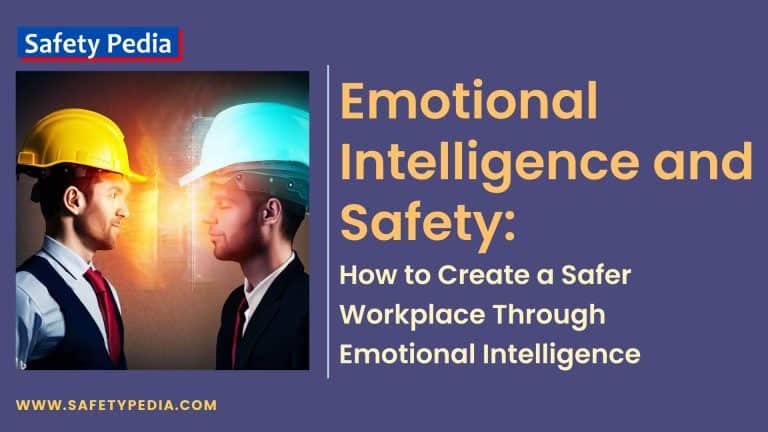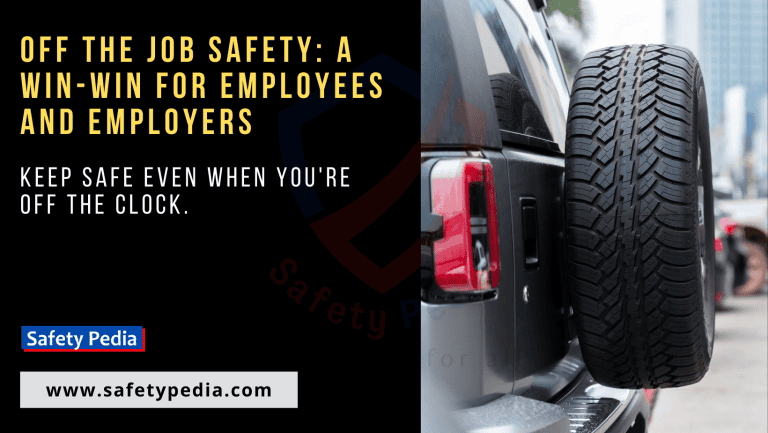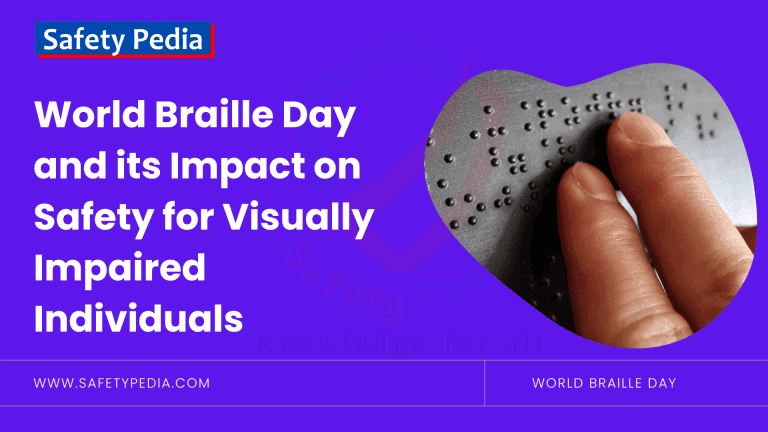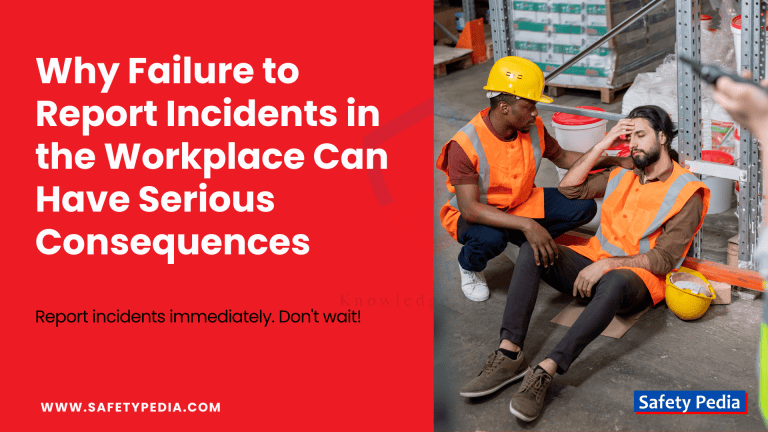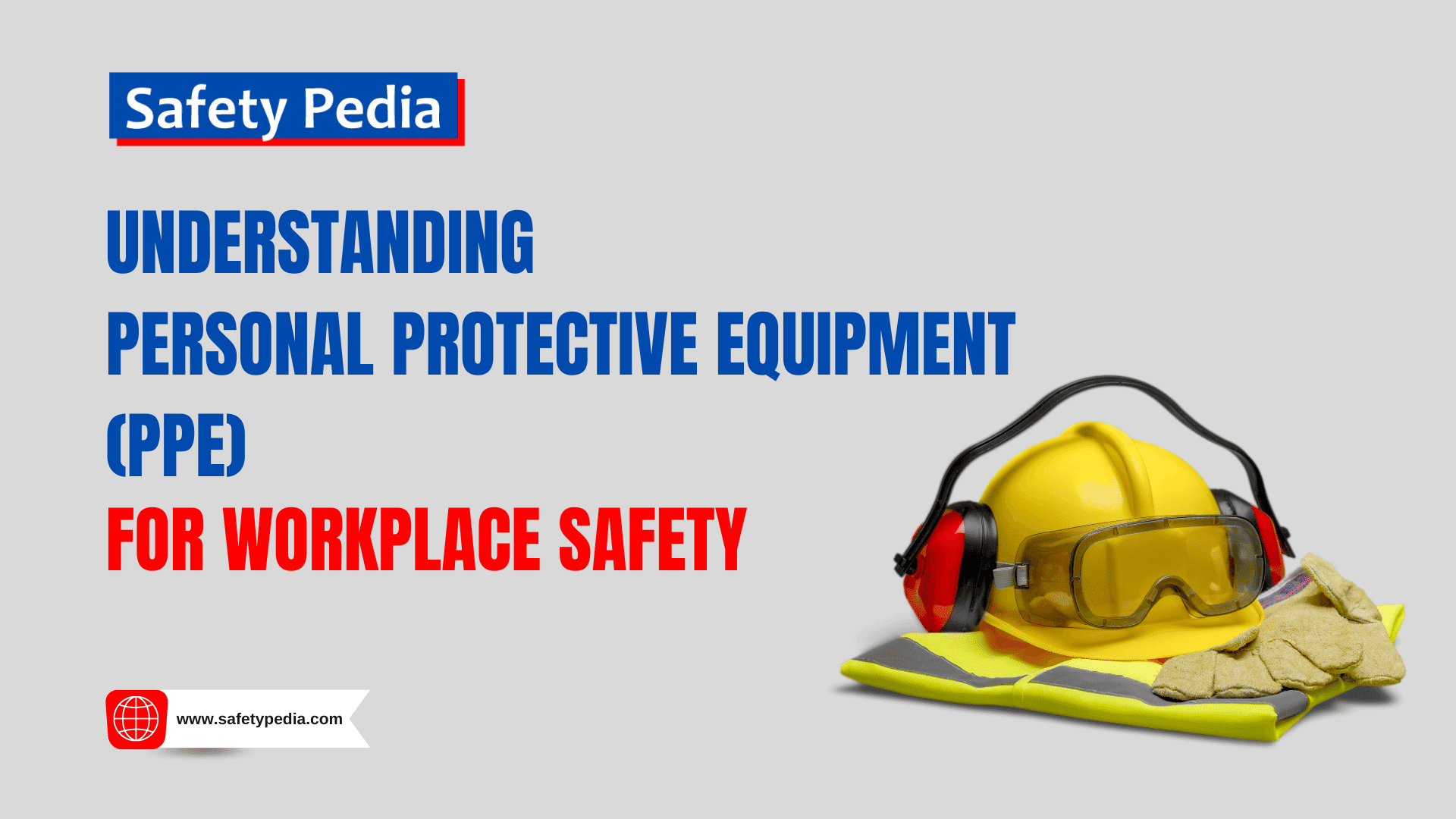
What is personal protective equipment (PPE)?
Personal protective equipment (PPE) refers to specialised equipment, clothing, and accessories designed to protect people from physical, biological, chemical, ergonomic, and other workplace hazards. The purpose of PPE is to minimise the risks and exposure to workers while performing their jobs.
PPE can include safety helmets, safety shoes, safety goggles, gloves, earplugs or earmuffs, respirators, full-body suits, and many other specialized items. The specific types of PPE that are required for a particular job depending on the type of work being performed, the hazards present, and the level of risk associated with the job.
It is essential to ensure that PPE is selected wisely, used correctly, maintained, and stored properly.
Proper training and education on PPE use are vital to ensure that PPE is used effectively and safely for protection. Failure to use appropriate PPE can result in serious injury, illness, or even death.
Personal Protective Equipment Subpart I 29 CFR 1910.132
29 CFR 1910.132 is a regulation issued by the Occupational Safety and Health Administration (OSHA) in the United States. 29 CFR 1910.132 regulation outlines the general workplace requirements for personal protective equipment (PPE). The regulation is part of the Occupational Safety and Health Standards for General Industry and requires that employers assess workplace hazards and provide personal protective equipment (PPE) to employees as needed1.
According to this regulation, employers must assess the workplace to determine if any hazards are present that require using PPE. If such hazards are present, the employer must provide appropriate PPE to their employees, and the employees must use it properly. In some cases, employees may be allowed to use their own PPE, but the employer is still responsible for ensuring that the equipment meets the necessary safety standards. The employer must also ensure that employees are trained in the proper use and care of PPE.
The regulation outlines the general requirements for PPE, including the types of equipment that may be needed, such as eye and face protection, respiratory protection, and hand protection. The regulation also includes specific requirements for the design and construction of PPE and guidelines for proper maintenance and inspection.
The purpose of 29 CFR 1910.132 is to ensure that employees are protected from workplace hazards by providing them with appropriate PPE and to minimise the risk of injury or illness in the workplace. Compliance with the regulation is mandatory for employers in the United States.
For example, logging boots are required by 29 CFR 1910.266(d)(1 )(v), which outlines specific requirements for PPE in the logging industry. Everyday clothing, such as long-sleeve shirts, long pants, and street shoes may not provide adequate protection against the hazards present in this industry. Overall, 29 CFR 1910.132 emphasizes the importance of identifying workplace hazards and providing appropriate PPE to protect employees from harm.
Personal Protective Equipment At Work Regulations 1992
The Personal Protective Equipment at Work Regulations 1992 (often referred to as PPE regulations or PPEW Regulations) is a UK statutory instrument introduced to provide a framework for using personal protective equipment in the workplace. The regulations were created in response to a European Union Directive (89/686/EEC) that aimed to harmonize the regulations on PPE across member states2•
The PPE regulations require employers to provide and ensure that workers wear suitable PPE where risks to health and safety cannot be adequately controlled by other means.
The regulations define PPE as any equipment that is intended to be worn or held by a person at work and that protects them against one or more risks to their health and safety. The PPE regulations apply to all workplaces where PPE is required, including industrial, construction, healthcare, agriculture and other sectors. By complying with these regulations, employers can help ensure the safety and well-being of their workers and avoid potential legal consequences for non-compliance.
Some of the key requirements of the PPE regulations include:
- Conducting a risk assessment to identify workplace hazards and determine the need for PPE.
- Selecting suitable PPE that are appropriate for the risks identified and is CE marked.
- Ensuring that PPE is properly maintained, and stored and that workers receive adequate training on its use.
- Providing workers with information on the risks associated with their work and the PPE being used.
- Ensuring that workers use the PPE provided and that it is regularly inspected and replaced if damaged.
- Consulting with workers or their representatives on the selection and use of PPE.
European Union Directive (89/686/EEC) for personal protective equipment (PPE)
The European Union Directive 89/686/EEC is a legal framework that sets out the basic health and safety requirements for personal protective equipment (PPE) that is intended to be used by workers
in the European Union (EU). The Directive defines PPE as any device or appliance designed to be worn or held by an individual for protection against one or more health and safety hazards•
The purpose of the Directive is to ensure that all PPE placed on the market within the EU meets certain safety and performance standards and that it is properly labeled and accompanied by appropriate instructions for use. The Directive also requires manufacturers to conduct appropriate testing and certification procedures before placing PPE on the market.
In order to comply with the Directive, manufacturers must meet a number of essential health and safety requirements, including ensuring that their PPE is designed and manufactured in such a way as to provide adequate protection against the hazards for which it is intended. PPE must also be tested and certified by an approved third-party organization before it can be sold in the EU.
Employers who provide PPE to their employees must ensure that the PPE meets the requirements of the Directive and is properly used and maintained. They must also provide training to employees on the proper use and care of PPE.
The Directive has been revised and updated several times, most recently in 2016 with the introduction of the new PPE Regulation (EU) 2016/425, which replaces the Directive. The new Regulation aims to simplify and streamline the regulatory framework for PPE in the EU, while also increasing the level of protection provided to users.
New PPE Regulation (EU) 2016/425
The new PPE Regulation (EU) 2016/425 is a regulatory framework that replaced the previous European Union Directive 89/686/EEC on personal protective equipment (PPE). The New PPE Regulation (EU) 2016/425 is a regulation of the European Parliament and the Council that was adopted on March 9, 2016. Its objective is to ensure common standards for personal protective equipment (PPE) across all Member States of the European Union. The regulation lays down requirements for the design and manufacture of PPE, and it aims to make such equipment readily available on the market while ensuring its safety and quality4.
The Regulation came into force on April 21, 2018, and introduced new requirements for PPE manufacturers, importers, distributors, and users in the European Union (EU). It applies to all types of PPE, including those intended for use in the workplace, such as helmets, gloves, eye protectors, and respiratory protective equipment. The new regulation places greater responsibility on manufacturers to ensure that their products comply with the requirements, and it also includes stricter rules for the testing and certification of PPE. The New PPE Regulation (EU) 2016/425 also
sets out new requirements for the labeling and documentation of PPE, and it provides for increased market surveillance to ensure that non-compliant products are removed from the market. It is intended to enhance the protection of workers and consumers, while also promoting the free movement of PPE within the European Union.
The main objective of the Regulation is to enhance the safety and health of workers who use PPE by ensuring that all PPE placed on the EU market is safe and effective. To achieve this, the Regulation sets out a series of essential health and safety requirements that PPE must meet before it can be sold in the EU. PPE must be designed and manufactured to provide protection against one or more risks that may threaten the user’s health or safety. In addition, PPE must comply with relevant European harmonized standards and be marked with the CE (Conformite Europeenne) symbol.
The Regulation also strengthens the obligations of manufacturers, importers, and distributors by requiring them to carry out conformity assessments, including risk assessments and testing, to ensure that the PPE meets the essential requirements. Manufacturers must also provide clear and understandable instructions for use and carry out sample testing and batch testing to ensure ongoing compliance.
Users of PPE, including employers and employees, also have obligations under the Regulation. Employers must ensure that the PPE is suitable for the risks present in the workplace and provide training to their employees on how to use and maintain the PPE properly. Employees must use the PPE correctly and take reasonable care of it. The new PPE Regulation aims to improve the level of protection provided by PPE in the EU, while also simplifying and harmonizing the regulatory framework for PPE across member states. It is part of a broader set of measures aimed at promoting safe and healthy working conditions for all workers in the EU.
Importance of Personal protective equipment (PPE)
Personal protective equipment (PPE) is important for several reasons, including:
- Protection from Workplace Hazards: PPE is designed to protect workers from workplace hazards that can cause injury or illness. It provides a physical barrier between the worker and the hazard, reducing the risk of exposure or injury.
- Legal Obligations: Employers have a legal obligation to provide a safe working environment for their workers, including the provision of PPE. In many countries, this obligation is enshrined in labor laws and regulations, and failure to comply with these laws can result in legal consequences, such as fines or penalties. The provision of PPE is necessary to comply with these legal obligations and protect workers from workplace hazards.
- Ethical Obligations: In addition to legal obligations, employers also have an ethical obligation to provide a safe working environment for their workers. Ethical obligations are based on the principles of fairness and responsibility, and they require employers to take reasonable steps to protect workers from harm. Providing PPE is an ethical obligation because it shows that the employer values the health and safety of their workers and is committed to reducing the risk of workplace injuries and illnesses.
- Health and Safety of Workers: PPE is essential for maintaining the health and safety of workers, reducing the risk of illness, injury, and death in the workplace.
- Increased Productivity: By providing workers with the necessary PPE, they are better protected and can focus on their tasks, leading to increased productivity.
- Confidence and Peace of Mind: The use of PPE can give workers confidence and peace of mind, knowing that they are protected from potential hazards.
- Reduced Costs: The use of PPE can reduce the costs associated with workplace accidents and injuries, including medical expenses, lost productivity, and worker compensation claims.
Overall, the importance of PPE cannot be overstated. By providing workers with appropriate PPE, employers can ensure a safe and healthy work environment, protect their workers from potential hazards, and avoid costly accidents and injuries. By fulfilling their legal and ethical obligations to provide PPE, employers can ensure a safe and healthy work environment, promote worker wellbeing, and maintain a positive reputation as responsible and caring employers.
What is a personal protective equipment program?
A Personal Protective Equipment (PPE) program is a systematic approach to selecting, providing, using, storing, training, education, and maintaining PPE in the workplace. A PPE program is designed to ensure that workers are protected from workplace hazards by providing appropriate PPE and that the PPE is used and maintained properly. A well-designed PPE program can help to reduce the risk of workplace injuries and illnesses, and can also help to ensure compliance with occupational health and safety regulations.
The following are some of the key elements of a comprehensive PPE program:
- PPE Policy: A written PPE policy should be developed and communicated to all employees, outlining the responsibilities of both the employer and the employees with respect to the use and maintenance of PPE. It must be integrated with the safety policy.
- Hazard Assessment: A thorough evaluation of workplace hazards should be conducted to determine the type and level of PPE that is required. A Safe System of Work SSOW can be consulted while carrying out hazard assessment.
- PPE Selection: Based on the results of the hazard assessment, appropriate PPE should be selected for each hazard.
- Training and Instruction: All employees should be trained on the proper use, care, and maintenance of PPE, and should be provided with instructions on how to properly don, doff, and adjust PPE.
- Fit Testing: PPE that requires a tight fit, such as respirators, should be fit tested to ensure that the worker is properly protected.
- Maintenance of PPE: PPE should be maintained regularly to ensure that it is functioning properly. For some PPE repair is prohibited such as repairing a damaged lanyard, therefore ensure to follow the maintenance requirements.
- Inspection: PPE should be inspected regularly to ensure that it is functioning properly. Organizations can develop checklists and set a frequency to inspect each PPE. It is necessary to inspect the PPE prior to use.
- Record Keeping: Records should be kept on the type of PPE used, employee training, fit testing, and maintenance and inspection records.
- Program Evaluation: The PPE program should be reviewed periodically to ensure that it is meeting its objectives and to identify areas for improvement.
- Feedback: Make a mechanism to receive feedback on the usage of PPE from the users. Note down the suggestions or complaints and share them with the management for improvement. Suggestions also need to be shared with manufacturers to improve the PPE design.
With a PPE policy in the program, employers can establish clear guidelines and expectations for the use of PPE in the workplace. This can help to ensure that all employees understand their roles and responsibilities when it comes to PPE and can help to promote a culture of safety in the workplace.
The PPE policy can also help to ensure compliance with occupational health and safety regulations and can provide a basis for continuous improvement of the PPE program. By implementing a comprehensive PPE program, employers can help to create a safer workplace, reduce the risk of injuries and illnesses, and ensure compliance with occupational health and safety regulations.
What is a PPE matrix?
A Personal Protective Equipment (PPE) matrix is a tool used to determine the appropriate PPE for a particular task or job in the workplace. The matrix typically lists the various hazards associated with the task or job, and the corresponding PPE required to protect against those hazards. The PPE matrix can also include information on the specific type, size, and model of PPE required.
The PPE matrix is often developed as part of a hazard assessment, which identifies the potential hazards associated with a particular task or job, and the controls needed to mitigate those hazards. The matrix can be used as a quick reference guide for workers, supervisors, and safety professionals to identify the appropriate PPE for a given task or job.
A typical PPE matrix may include the following information:
- Task or job description
- Potential hazards associated with the task or job
- PPE is required for each hazard, such as safety glasses, gloves, respirators, hearing protection, etc.
- Specific type, size, and model of PPE required
- Additional considerations, such as fit testing, maintenance requirements, and proper donning and doffing procedures.
The PPE matrix can help to ensure that the appropriate PPE is used for each task or job, which can reduce the risk of workplace injuries and illnesses. It can also help to ensure compliance with occupational health and safety regulations by providing a clear and concise guide for selecting and using PPE in the workplace.
Can personal protective equipment protect employees from all workplace hazards?
No, Personal protective equipment (PPE) can protect employees from many workplace hazards but it may not be effective or appropriate for all types of workplace hazards. It is essential to note that PPE should be used in conjunction with other workplace hazard control measures, such as engineering controls, and/or administrative controls, to ensure that employees are adequately protected. Personal protective equipment should not be used as a substitute for engineering, and/or administrative controls. For example, respiratory protection may be necessary for workers who are exposed to toxic vapors, but the employer should also try to eliminate or reduce the source of the vapors through engineering controls, such as improved ventilation or changes to the work process.
Can you repair personal protective equipment?
Repairing Personal Protective Equipment (PPE) while maintaining it needs careful consideration. It depends on the type and extent of damage to the equipment. In some cases, minor repairs can be made, such as replacing elastic bands or straps. However, if the damage is severe, then replace the PPE altogether. It’s essential to follow the manufacturer’s guidelines and standards when repairing or maintaining PPE to ensure that it remains effective in protecting the user. However, depending on the type of damage and the specific PPE, some types of PPE may be repairable while others may need to be replaced.
As a general rule, personal protective equipment (PPE) should not be repaired or altered by the user. This is because any changes to the equipment may compromise its effectiveness and put the user at risk.
For example, some PPE, such as goggles or face shields, may have replaceable lenses or shields that can be swapped out if they become damaged. Similarly, some types of gloves or clothing may be repairable if the damage is minor, such as a tear that can be mended.
However, it is important to note that some types of PPE, such as N95 respirators, are typically intended for single use and cannot be effectively repaired or reused.
Additionally, any repairs or modifications made to PPE should be done in accordance with the manufacturer’s instructions to ensure the PPE continues to provide the necessary level of protection. If you need to repair PPE, it is important to consult with a qualified professional or manufacturer to ensure that the repair is done correctly and the PPE remains effective for its intended use.
For example, in case of a tear or abrasion of the lanyard, the Full body harness should never be repaired. It must be replaced to provide protection to its wearer. Similarly, if a hard hat is dropped or otherwise impacted, it should be replaced, even if there are no visible signs of damage. If PPE is worn out or no longer functioning as intended, it should be replaced immediately. Regular inspections of PPE can help identify any potential issues before they become a safety hazard.
What are the different types of personal protective equipment (PPE)?
There are many different types of personal protective equipment (PPE), each designed to protect workers from specific hazards. Here are some of the most common types of PPE:
- Head Protection: Safety helmets or hard hats are used to protect the head from falling objects, electrical hazards, and other head injuries.
- Eye and Face Protection: Safety goggles, face shields, and other protective eyewear are used to protect the eyes and face from flying debris, chemicals, and other hazards.
- Respiratory Protection: Respirators, masks, and other breathing devices are used to protect against inhalation hazards, such as dust, fumes, and gases.
- Hand Protection: Gloves are used to protect the hands from cuts, impact, abrasion, punctures, chemicals, and other hazards.
- Foot Protection: Safety shoes or boots are used to protect the feet from falling objects, electrical hazards, slip hazards, and other foot injuries.
- Body Protection: Coveralls, aprons, and other specialized clothing are used to protect the body from chemical, biological, and other hazards.
- Hearing Protection: Earplugs, earmuffs, and other hearing protection devices are used to protect the ears from loud noise or other acoustic hazards.
The specific type of PPE required for a particular job depends on the type of work being performed, the hazards present, and the level of risk associated with the work. It is important for employers to assess workplace hazards and determine the appropriate PPE for employees to minimize risks and exposures while performing their jobs.
List of Personal Protective Equipment
Personal Protective Equipment (PPE) refers to equipment designed to protect an individual from potential hazards in their work environment. The following is a sample list of PPE:
1. Head protection:
- Hard hats
- Bump caps
- Hair nets
2. Eye and face protection:
- Safety glasses
- Goggles
- Face shields
- Face visor
- Fluid Resistant Shields
- Welding helmets
- Beard nets
3. Hearing protection:
- Earplugs
- Earmuffs
- Ear canals
4. Respiratory protection:
- Dust masks
- N95 mask
- Respirators
- Self-contained breathing apparatus (SCBA)
- Air-supplied breathing apparatus
5. Hand and arm protection:
- Gloves
- Nitrile Rubber Gloves
- Latex gloves
- Cut Resistant Gloves
- Impact Resistant Gloves
- Steel Mesh Gloves
- Gauntlets
- Heat-resistant gloves
- Insulated Gloves
- Sleeves
6. Foot and leg protection:
- Safety shoes
- Safety boots
- Leggings
7. Body protection:
- High visibility clothing
- Aprons
- Lab coats
- chemical splash suit
- Coveralls
- Vests
- Full Body Harnesses
- Life jackets
It is important to note that the type of PPE required will depend on the specific workplace hazards and tasks performed. The appropriate PPE should always be selected and worn in accordance with the employer’s instructions and industry standards.
What is the compatibility of a PPE?
Compatibility of personal protective equipment (PPE) refers to the ability of different types of PPE to be used together without reducing their individual effectiveness. When selecting and using PPE, it is important to consider the compatibility of the PPE with other PPE, equipment, and substances used in the workplace.
For example, when using respiratory protection (e.g. a respirator), it is important to ensure that the respirator is compatible with other PPE that may be required, such as eye protection or a hard hat. In some cases, a respirator may not fit properly with other PPE, which can compromise the effectiveness of both pieces of equipment.
Similarly, when using chemical protective clothing (CPC), it is important to consider the compatibility of the CPC with the chemicals that will be handled or encountered in the workplace. Some chemicals can degrade or penetrate certain types of CPC, reducing their effectiveness. In these cases, an alternative CPC should be selected that is compatible with the specific chemicals being used.
To ensure compatibility with PPE, it is important to follow the manufacturer’s instructions and to consult with safety professionals or PPE experts as needed. Hazard assessments and PPE matrices can also help to identify potential compatibility issues and to ensure that appropriate PPE is selected and used for each task.
When using a safety helmet that is designed to protect the head from falling objects or impact, it is important to consider the compatibility of the helmet with other PPE that may be required for the task. In some cases, workers may need to wear ear muffs to protect their hearing from loud noises, such as those produced by heavy machinery.
To ensure compatibility, it is important to select ear muffs that can be used with the safety helmet without interfering with the helmet’s performance. For example, ear muffs with a low profile or slim design may be more compatible with safety helmets, as they can fit snugly against the ears without interfering with the helmet’s suspension system. In some cases, specialized adapters or attachments may be needed to allow the ear muffs to be securely attached to the helmet.
Ensuring compatibility between PPE is essential for ensuring that each piece of equipment provides maximum protection without interfering with the performance of other equipment. By considering compatibility when selecting and using PPE, workers can ensure that they are adequately protected from workplace hazards.
Is it necessary to consider Personal Protective Equipment Fit for males and females?
Yes, it is necessary to consider the suitability of Personal Protective Equipment (PPE) for both males and females. Men and women can have different body shapes and sizes, and the use of PPE that is not properly designed and fitted for each individual can result in reduced protection and increased risk of injury or illness. For example, PPE designed for men may be too large for women, which can result in a poor fit and reduced protection. Similarly, PPE designed for women may be too small for men, which can also result in a poor fit and reduced protection. Inadequate fit can compromise the performance of the PPE, and expose the worker to workplace hazards.
In the past, PPE has been primarily designed for male body types, which can result in ill-fitting PPE for females. Many female workers fail fit tests because PPE is not designed to fit them properly. This can result in females accepting ill-fitting PPE as the norm, which can compromise their safety. Properly fitting PPE is essential for both male and female workers, as it can help them feel more confident and be more productive while protecting them from hazardous substances. Therefore, it is crucial to consider the suitability of PPE for both male and female workers to ensure their safety and well-being.
Employers must ensure that PPE is properly sized and fitted for employees, regardless of gender, to ensure optimal protection. Employers should provide a range of sizes and styles to accommodate the different body shapes and sizes of their workforce, and ensure that workers are trained on how to properly use and maintain their PPE.
In addition, some PPE, such as respirators, may require fit testing to ensure that they provide adequate protection for each individual. Fit testing is a process that determines the suitability of a respirator based on an individual’s facial characteristics and the respirator’s design. Fit testing should be performed by a competent person for all employees who are required to wear a respirator, regardless of gender.
What are the Storage Requirements for Personal Protective Equipment?
Proper storage of personal protective equipment (PPE) is important to maintain its effectiveness and ensure it is readily available when needed. The following are some safe storage requirements for PPE:
- Store PPE in a clean and dry location to prevent damage from moisture, sunlight, heat, or cold temperatures.
- Ensure that PPE is stored away from chemicals, flammable materials, or other hazards that may cause contamination or damage.
- Store PPE in a location that is easily accessible and visible to workers to encourage regular use.
- Store PPE in its designated place or container to prevent misplacement or loss.
- Inspect PPE regularly to ensure that it is in good condition and replace or repair any damaged or worn-out equipment immediately.
- Provide separate storage areas for PPE that is for different parts of the body to prevent cross-contamination.
- Train workers on the importance of proper storage and maintenance of PPE to promote responsible use.
- Label the storage area for PPE with clear signage to avoid confusion.
By following these safe storage requirements for PPE, workers can ensure that they are properly protected while performing their tasks, and that their PPE remains in good condition, increasing its lifespan and effectiveness.
Is labeling PPE a good practice?
Yes, labeling personal protective equipment (PPE) for identification of the user is another important safe storage requirement. Labeling can help prevent PPE from being misplaced or shared among workers and can also help identify any faulty or damaged equipment that needs to be replaced or repaired.
Here are some tips for labeling PPE:
- Label the PPE with the name or identification number of the user to avoid confusion and ensure that each worker is using their own equipment.
- Use a waterproof or weather-resistant label to ensure the label remains legible and attached to the equipment.
- Use a bright or high-contrast colour for the label to make it easily visible and distinguishable from other PPE labels.
- Ensure the label does not interfere with the functionality of the PPE, such as obstructing the view of safety goggles or impeding movement with gloves.
- Update the label if there is a change in user or if the equipment has been replaced or repaired.
By labeling PPE for identification of the user, workers can ensure that they are using their own equipment, which helps prevent the spread of infectious diseases and cross-contamination. It also helps workers take responsibility for their equipment, leading to better maintenance and care, which increases the lifespan and effectiveness of the PPE.
Advantages of Personal Protective Equipment (PPE):
- Protection from Workplace Hazards: PPE provides a physical barrier between workers and workplace hazards, reducing the risk of exposure to harmful materials, chemicals, or physical hazards.
- Improved Safety: By reducing the risk of injury or illness, PPE can help create a safer work environment for employees.
- Cost-Effective: PPE is a cost-effective way to reduce the risk of injury or illness compared to other risk mitigation measures such as engineering controls or administrative controls. But in the long run, it is not cost-effective.
- Flexibility: PPE can be easily adapted to different job tasks and hazards, making it a versatile safety solution.
- Increased Confidence: PPE can help boost employee confidence and morale, knowing that they are well protected from potential hazards.
Limitations of Personal Protective Equipment (PPE):
- Incomplete Protection: PPE does not provide complete protection against all hazards and must be used in combination with other safety measures such as engineering and administrative controls.
- Dependence on User Compliance: PPE only provides protection if it is used correctly, so there is a dependence on workers to use PPE consistently and correctly.
- Training Requirements: PPE requires adequate training and education to be used effectively, and improper use or inadequate training can result in reduced protection and increased risk of injury or illness.
- Comfort and Fit: PPE must fit properly to provide adequate protection and can be uncomfortable for workers, which can lead to reduced compliance.
- Maintenance and Replacement: PPE requires regular maintenance and inspection to ensure its effectiveness, and damaged or expired PPE must be replaced promptly.
Overall, while PPE provides important protection against workplace hazards, it has its limitations and must be used in combination with other safety measures to provide adequate protection. Employers must carefully consider the advantages and limitations of PPE when selecting and implementing a safety program to ensure the protection and well-being of their employees.
Do employers have a duty to provide personal protective equipment
Yes, employers have a legal duty to provide personal protective equipment (PPE) to their employees in many countries around the world, including the United States, Canada, the United Kingdom, and many other countries. This duty is usually outlined in workplace health and safety legislation or regulations.
The exact requirements for providing PPE can vary by country and by industry, but in general, employers must provide PPE if there are workplace hazards that cannot be adequately controlled by other means. This may include hazards such as exposure to chemicals or hazardous materials, noise, radiation, or physical hazards such as falling objects or sharp edges.
Employers must also ensure that the PPE provided is suitable for the task and the worker, is properly maintained and is replaced when necessary. They must also provide workers with adequate training and instruction on the use, care, and limitations of PPE.
Failure to provide adequate PPE can result in legal consequences, such as fines, penalties, or legal liability for workplace injuries or illnesses. Additionally, employers have an ethical obligation to provide a safe working environment for their employees and to take reasonable steps to protect them from harm. Providing PPE is an important part of fulfilling this obligation and demonstrating a commitment to worker safety and well-being.
Personal Protective Equipment (PPE) – Last Control in Hierarchy of Risk Control
Personal Protective Equipment (PPE) is one of the risk controls in the hierarchy of controls, which is a hierarchy used to determine the most effective way to mitigate workplace hazards. The hierarchy of controls is a step-by-step approach to identifying and addressing workplace hazards, with the goal of eliminating or minimising the risks associated with these hazards. The hierarchy of controls consists of the following five levels:
- Elimination: The most effective way to control a hazard is to eliminate it entirely. This can be achieved through the design or re-design of work processes or the physical environment.
- Substitution: When elimination is not possible, substitution can be used to replace a hazardous substance, material or process with a less hazardous one.
- Engineering Controls: This includes the use of equipment and systems that can help to reduce exposure to a hazard, such as ventilation systems or barriers.
- Administrative Controls: This includes the use of procedures, policies, and training to help minimize the risk of exposure to a hazard.
- Personal Protective Equipment (PPE): The last resort in the hierarchy of controls, PPE is a physical barrier between the worker and the hazard. It include items such as safety glasses, respirators, gloves, and hard hats.
The use of PPE is not always the most effective way to control workplace hazards, as it does not eliminate the hazard, it only provides a physical barrier to protect the worker. Therefore, PPE should only be used when other risk controls have been deemed inadequate or are not feasible.
Employers should always strive to use the highest level of control available to address workplace hazards, starting with elimination and working their way down the hierarchy of controls. By following this approach, employers can help to create a safer workplace and minimize the risk of injury or illness for their employees.
Is it possible that PPE may create an additional risk
Yes, it is possible that the use of personal protective equipment (PPE) may create an additional risk if it is not used properly or if it is not appropriate for the task or environment. Here are a few examples of how PPE can create additional risks:
Wearing PPE can create a false sense of security, leading to the neglect of other safety measures. This can happen if people assume that PPE alone is enough to protect them, take unnecessary risks, and do not take other precautions to prevent accidents or exposure to hazards.
Wearing PPE can make it harder to perform certain tasks or create new hazards. For example, wearing gloves can make it more difficult to grasp objects or handle small parts, increasing the risk of dropping or mishandling them. Wearing gloves that are too loose or too tight can reduce dexterity or create a risk of injury. Wearing Similarly, wearing a respirator can impair vision or hearing, making it harder to see or hear warning signals. The use of a full-body harness may become entangled with other objects and cause a trip or fall.
Similarly, the harness hook can stuck on a lifeline, causing a jerk that could result in a fall from height. The use of a helmet with a chin strap may cause entanglement while working in congested machinery and cause neck injury. If a person uses a respirator that is not appropriate for the specific hazard can fail to protect the user or create a false sense of security.
To minimize the risk of PPE creating additional hazards, it is important to choose the appropriate type of PPE for the task and environment, ensure that it fits properly and is used correctly, and provide training on the proper use and limitations of the PPE.
Why PPE is considered the last line of defense?
Personal Protective Equipment (PPE) is often considered the last line of defense in protecting workers from workplace hazards because it is the least effective means of hazard control when compared to other types of risk controls, such as engineering or administrative controls.
The use of PPE is considered the last line of defense because it is not always possible to eliminate or substitute a hazard, and engineering or administrative controls may not adequately reduce the risk of exposure. PPE is a last resort because it only provides protection for the person wearing it, and does not remove or reduce the hazard itself. PPE can also be less effective if it is not used or maintained properly, and can cause discomfort or restrict movement, which can lead to reduced compliance.
Therefore, while PPE is an important part of protecting workers from workplace hazards, it should only be used as a last line of defense after other types of risk controls have been exhausted. Employers must always strive to use the highest level of control available to address workplace hazards, starting with elimination and working their way down the hierarchy of controls.
Do’s and dont’s of Personal Protective Equipment
Here are some general do’s and don’ts of personal protective equipment (PPE):
Do’s:
- Do use the appropriate PPE for the job or task at hand, as identified by a hazard assessment or PPE matrix.
- Do ensure that PPE fits properly and is comfortable to wear for the duration of the task.
- Do inspect PPE before each use to ensure that it is in good condition and functioning properly.
- Do properly don and doff PPE according to the manufacturer’s instructions or training guidelines.
- Do properly store and maintain PPE when not in use, such as keeping it clean, dry, and in a designated storage area.
- Do report any damaged or malfunctioning PPE to a supervisor or safety professional.
Don’ts:
- Don’t use PPE that is damaged or not functioning properly.
- Don’t modify PPE in any way that could compromise its effectiveness or performance.
- Don’t share PPE with other workers, as it may not fit properly or may be contaminated with hazardous materials.
- Don’t use PPE as a substitute for other controls, such as engineering controls or administrative controls.
- Don’t wear PPE outside of designated work areas or off the job site.
Following these do’s and don’ts can help ensure that PPE is used effectively to protect workers from workplace hazards, and can promote a safe and healthy workplace. It is important to remember that proper PPE use is just one part of a comprehensive safety program, and that other controls should also be implemented to reduce workplace hazards.
References
- https://www.osha.gov/laws-regs/regulations/standardnumber/1910/1910.132
- https://www.legislation.gov.uk/uksi/1992/2966/contents/made
- https://eur-lex.europa.eu/legal-content/en/ALL/?uri=CELEX%3A31989L0686
- https://osha.europa.eu/en/legislation/directive/regulation-eu-2016425-personal-protective-equipment
Your one click can make a difference
Keep sharing and promoting health and safety awareness!
Related posts:

Understanding Leading and Lagging Indicators in Safety: A Comprehensive Guide
Gain a thorough understanding of the difference between leading and lagging indicators in safety and how they can help create a safer work environment. Learn how to implement these indicators effectively and ensure the well-being of your employees.
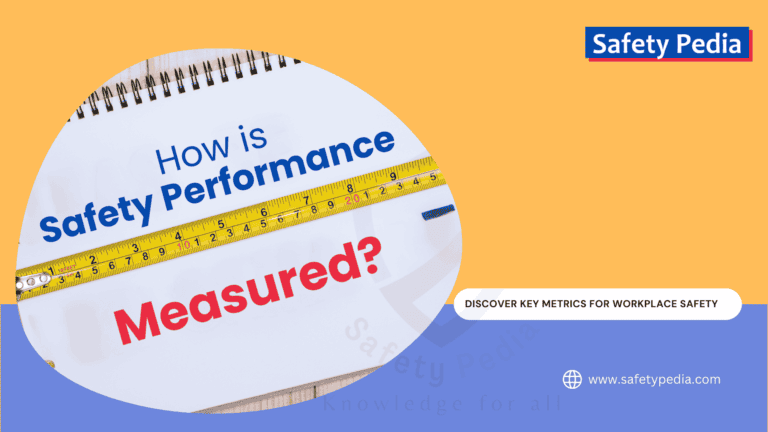
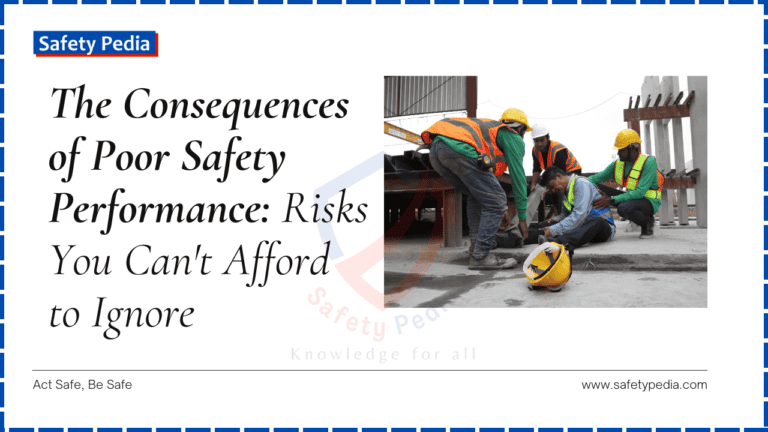
The Consequences of Poor Safety Performance: Risks You Can’t Afford to Ignore
Discover the potential consequences of poor safety performance in the workplace and how they can negatively impact both employees and the company as a whole.
Join Our Safety Community!
Stay informed with the latest tips and insights on occupational health, safety, and the environment.
